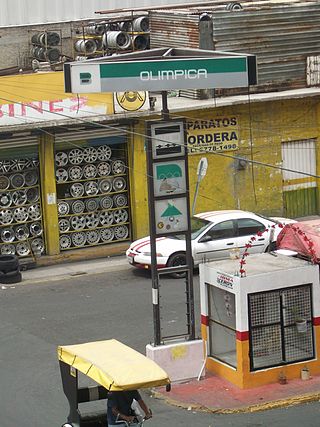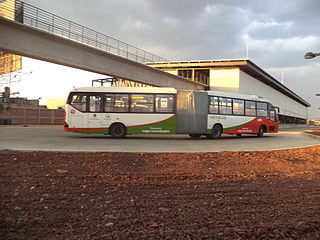
The Mexico City Metro is a rapid transit system that serves the metropolitan area of Mexico City, including some municipalities in the State of Mexico. Operated by the Sistema de Transporte Colectivo (STC), it is the second largest metro system in North America after the New York City Subway.

Buenavista is a station on the Mexico City Metro, in the Colonia Buenavista neighborhood of the Cuauhtémoc borough. It is the southwestern terminal station of Line B. It also offers connections to the Insurgentes Metrobús bus rapid transit line. In 2019, the station had an average ridership of 66,804 passengers per day, making it the tenth busiest station in the network.

Ferrería/Arena Ciudad de México is a station along Line 6 of the Mexico City Metro. It is located in the Azcapotzalco municipality, in the north of Mexico City. In 2019, the station had an average ridership of 23,779 passengers per day.

The Tren Suburbano is an electric suburban rail system in Mexico City. It is operated by Ferrocarriles Suburbanos with concessioned trains from Construcciones y Auxiliar de Ferrocarriles (CAF). It was designed to complement the extensive Mexico City metro system, Latin America's largest and busiest urban rail network.

Olímpica metro station is a station of the Mexico City Metro in the colonias (neighborhoods) of Jardines de Aragón and La Olímpica II, in Ecatepec de Morelos, State of Mexico, in the metropolitan area of Mexico City. It is an at-grade station with one island platform served by Line B, between Plaza Aragón and Ecatepec stations. The name of the station references the colonia of the same name and its pictogram depicts the Olympic rings. The station was opened on 30 November 2000, on the first day of service between Ciudad Azteca and Buenavista metro stations. The facilities are accessible to people with disabilities as there are tactile pavings and braille signage plates. In 2019, Olímpica metro station had an average daily ridership of 16,745 passengers, making it the eleventh most used on the line.

Ciudad Azteca metro station is a station of the Mexico City Metro along Carlos Hank González Avenue, in Ecatepec de Morelos, State of Mexico, in the metropolitan area of Mexico City. It is an at-grade station with two island platforms that serves as the northern terminus of Line B. It is followed by Plaza Aragón metro station. It serves the colonia (neighborhood) of Ciudad Azteca (es), from which the station takes its name. It is also adjacent to the north end of Mexico's busiest mall, Multiplaza Aragón. The station's pictogram features the silhouette of the neighborhood's glyph.

Line 5, also known as the Yellow Line from its color on the system map, is a rapid transit line of the Mexico City Metro network. It travels 15.6 kilometers (9.7 mi) along the boroughs of Gustavo A. Madero, Cuauhtémoc and Venustiano Carranza in northern, northeastern and eastern Mexico City, serving thirteen stations. The line was inaugurated on 19 December 1981, going from Pantitlán to Consulado station. In 1982, the line was expanded twice, first from Consulado to La Raza station on 1 July, and later from La Raza to Politécnico station on 30 August.

Buenavista is a commuter railway station in Mexico City. The station provided intercity train services from Ferrocarriles Nacionales de México. Since June 2008, the station serves as the terminus of the Tren Suburbano commuter rail service. Atop the ground-level station and tracks is one of the city's largest shopping malls, Forum Buenavista.

Colonia Buenavista is a colonia or neighbourhood in the Cuauhtémoc borough located northwest of the historic center of Mexico City. What would become the city's main train terminal, Buenavista Station, stood here 1873–1958, and a new Buenavista Station opened in its place in 1961. Though there is no longer intercity passenger service to or from Mexico City, the station is still the terminus of the Tren Suburbano commuter rail line, in a complex together with a major shopping mall, the Forum Buenavista. The colonia is also home to the offices of the Cuauhtémoc borough and the mega José Vasconcelos Library.

The Mexico City Metrobús Line 4 is a bus rapid transit line in the Mexico City Metrobus. It operates between Colonia Buenavista, in central Mexico City and the Mexico City International Airport in the Venustiano Carranza borough, in the east of the capital.

Lechería is a commuter railway station serving the Ferrocarril Suburbano, a suburban rail that connects the State of Mexico with Mexico City. The station is located in the municipality of Tultitlán, State of Mexico, north of Mexico City.

Tlalnepantla is a commuter railway station serving the Ferrocarril Suburbano, a suburban rail that connects the State of Mexico with Mexico City. The station is located in the municipality of Tlalnepantla, State of Mexico, north of Mexico City.

Fortuna is a commuter railway station serving the Ferrocarril Suburbano, a suburban rail that connects the State of Mexico with Mexico City. The station is located in the municipality of Azcapotzalco in the northern part of Mexico City.

Buenavista Station, also called Buenavista Terminal, was a passenger train station in Mexico City. The station opened in 1873 and since 1909, the station was fully operated by Ferrocarriles Nacionales de México. The station was closed in 2005. By June 2008, the station was replaced by the terminus of the Tren Suburbano commuter rail service.

Tultitlán is a commuter railway station serving the Ferrocarril Suburbano, a suburban rail that connects the State of Mexico with Mexico City. The station is located in the municipality of Tultitlán, State of Mexico, north of Mexico City.

Cuautitlán is a commuter railway station serving the Ferrocarril Suburbano, a suburban rail that connects the State of Mexico with Mexico City. The station is located in the municipality of Cuautitlán, State of Mexico, north of Mexico City.

A centro de transferencia modal, is a type of transport hub found mainly in Mexico City. Locally known as paraderos, these intermodal passenger transport stations allow commuters to transfer between different modes of public transit, generally between rail and bus systems. In Mexico City, their operations are supervised by Organismo Regulador de Transporte (ORT). Since 14 December 2010, the hubs became part of a decentralized organization. Out of the 40 operative CETRAMs existing in the city, 33 are found adjacent to Mexico City Metro stations.

The Mexibús Line I is a bus rapid transit (BRT) line in the Mexibús system. It operates between Felipe Ángeles International Airport in Zumpango, Ojo de Agua in Tecámac and Ciudad Azteca in Ecatepec de Morelos. It was the first line to be built and to be opened. It was inaugurated by the governor of the State of Mexico, Enrique Peña Nieto on 1 December 2010 with 24 stations. Another station was opened later. It is 20 kilometers (12 mi) long and was used by approximately 130,000 users per day during 2012. The line has four different types of services, including a service exclusive for women and children. The line operates with 75articulated Volvo 7300 BRT buses painted white with red, light green and dark green trim. It began free operations in October 2010.

The Mexibús Line II is a bus rapid transit (BRT) line in the Mexibús system. It operates between La Quebrada in Cuautitlán Izcalli and Las Américas in Ecatepec de Morelos. It was the second line to be built and the third to be opened. It was inaugurated by the governor of the State of Mexico, Eruviel Ávila on 12 January 2015 with 43 stations. It is 21.3 kilometers (13.2 mi) long. The line has two different types of services, and both include a service exclusively for women and children named Servicio Rosa. The line operates with 97 buses. On 8 October 2018, the Servicio Exprés was opened, going from Lechería to Ecatepec stations.




















